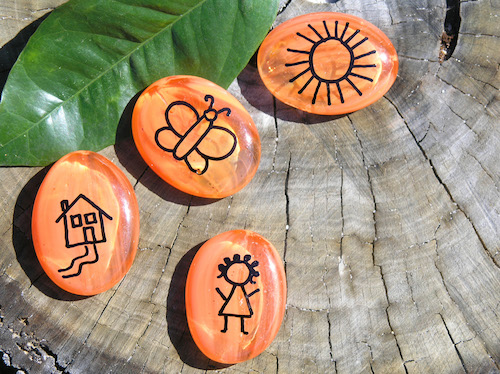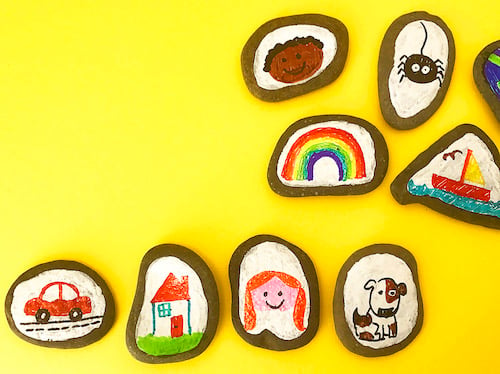“Mama, will you tell me a story to help me fall asleep?” asks my eight-year-old.
The act of telling stories is a tradition as old as humankind. With their potential to explain historical events, life lessons, beliefs and values, feelings, and emotions, stories can help children better understand the world of human interactions. Storytelling also promotes listening skills, inviting the listener to use their imagination and worldly experiences to create meaning.
I've always believed the most valuable part of storytelling is the connection fostered between teller and listener. Both my daughters find comfort in listening to stories – especially those from my own imagination or personal memories.
Introducing Story Stones
To introduce storytelling to your family, or if you're looking for new ideas, a set of "story stones" is a handy resource to have.
Story stones are a collection of small stones with pictures on them that can be used as storytelling prompts. They're particularly wonderful for creating collaborative stories.
How to Make Story Stones
Step 1: To get started, you and your children will need a collection of flat, smooth stones or gems. These can often be found at a discount store, hardware store, garden, or beach. To begin, it's best to make at least eight to ten stones.

Step 2: Have you or your children add pictures to your stones with a permanent marker, paint or paint pens. The pictures can be simple line drawings or more detailed, colored drawings.

If your stones are dark, paint a background first with white acrylic craft paint or correction fluid. Then have your children include pictures of everyday items such as buildings, vehicles, people, animals, and food. You can capture natural objects, household items, and even elements from your children's favorite stories, etc. Make sure to brainstorm picture suggestions together — you’re limited only by your imagination. And of course, don’t worry if your little drawings aren’t perfect either.
Time for Storytelling
Once your stones are ready it’s time to tell a story! I find it works best when me and my family are sitting around a table together, so it's often an activity we'll do as we eat lunch or dinner. Here are three ways your story stones can guide your family's storytelling experience:
1. Once upon a time: Begin by using your stones as prompts to tell an imaginary tale to your children. Place one stone on the table as a trigger for the beginning of your story, and add each subsequent stone as the story progresses. Start with shorter stories, using only five or six of the stones. Work towards longer stories, with more stones added. Once you’ve shared a story or two, invite your children to take turns using the stones tell stories of their own.
2. "Take a turn" stories: Once your children are confidently using the stones to create their own stories, try telling a "take a turn" story together. Place all of your stones face up on the table and decide who will go first. Invite that person to choose a stone and start the story. Each person then goes in turns to choose and add one stone from the collection to extend the story a little further, until all of the stones have been used. The best part — your family will never quite know where this type of story will take you!
3. Mystery stories: Turn all of the story stones face down on the table. Choose who'll go first and invite that person to choose one stone at random, and turn it over, using it as a prompt to start the story. Continue around the table, taking turns to flip over one stone at a time to extend the story. Alternatively, you can place all of the stones into a small cloth bag and take turns pulling out one at a time.
However you choose to share, the power of a story to create moments of connection and belonging for your children makes storytelling a fabulous way to spend time together.


